Most recent find: The sole complete tomb of an Egyptian pharaoh that has never been found before
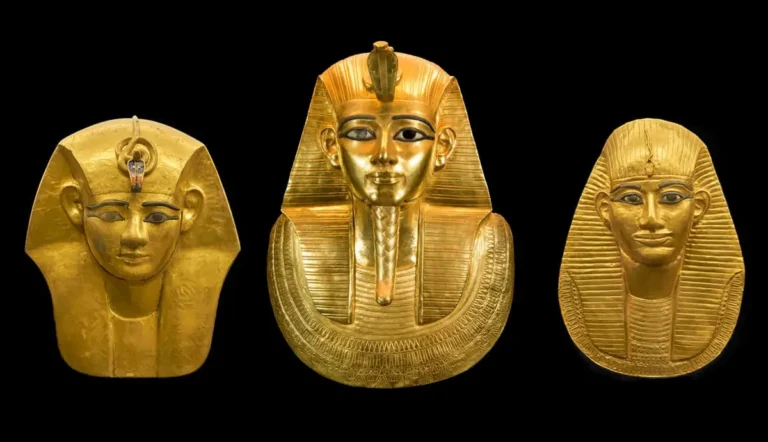
Virtually unknown, the discovery of three intact Egyptian Pharaoh’s tombs rivals King Tut’s discovery. This is the story of the gold of the Pharaohs and the Treasure of Tanis.
The tomb of Tutankhamun is one of the most fascinating discoveries ever made, but it wasn’t an intact discovery. It had been looted twice in Antiquity, and Howard Carter estimated that a considerable amount of jewelry was stolen. Throughout three millennia, about 300 Pharaohs ruled ancient Egypt, yet all royal Egyptian tombs had been broken into by thieves, even King Tut’s. But in 1939 Pierre Montet had one of the most important discoveries in archaeological history, the Tanis Treasures. He found a royal necropolis, including three Egyptian Pharaohs tombs intact with their gold and silver treasure. This is the tale of the gold treasures of Ancient Egypt.
Gold, Flesh of Egyptian Gods
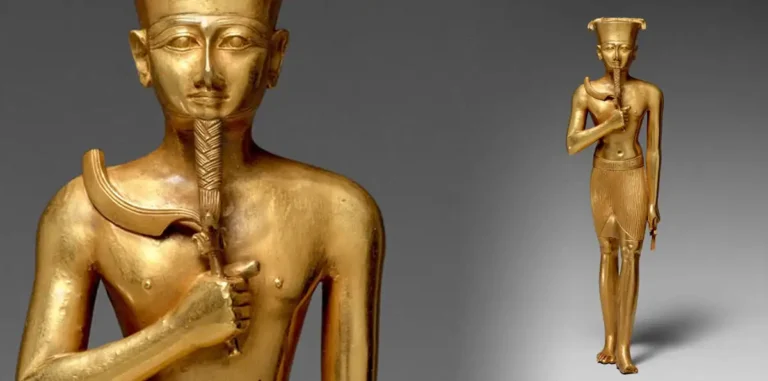
Why this fascination with gold? At the dawn of the ancient Egyptian civilization, people tried to make sense of the world around them. They envisioned that it started as an ocean of darkness and chaos. But then from the water emerged an island, the sun, the gods, and on the earth mound lush vegetation grew. At night, instead of seeing obscurity and confusion, they saw order, as the stars moved in unison.
Each day the sun brought life to the world. Each year the Nile fertilized the dry land. So they perceived a divine harmony in the world around them. And the balance of this fine clockwork of life was the sun.
In the desert one could find in rocks a metal of the same color as the sunshine. It could be melted and fashioned without ever tarnishing, so it seemed eternal. The aging sun god Ra was described as having “his bones turned into silver, his flesh into gold, and his hair into real lapis-lazuli”. For the ancient Egyptians, the gods’ flesh was made of the same substance as the sun, gold.
Gold, A Substance of Immortality
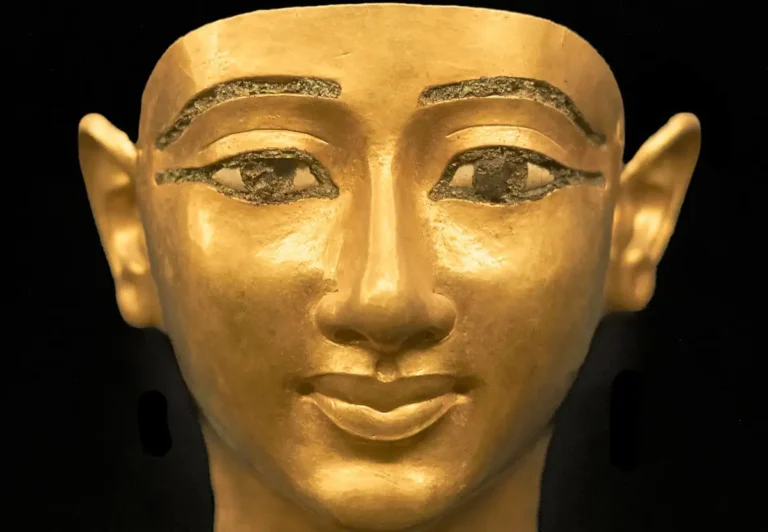
Get the latest articles delivered to your inbox
This is where lay the big misunderstanding about ancient Egyptian civilization. It is not a civilization with a morbid fascination with death, but the opposite, life, for eternity. Since the sun is reborn every morning, the Royal Egyptian tombs were built in the West. The idea was to join the sun in its nightly travel, and like him, be revived every morning.
This is how pyramids express perpetual rebirth. Originally covered in smooth white stone and with a gold and silver tip, they shone brightly looking like sun rays. Furthermore, they also symbolize the original earth mound of vegetation, the regeneration of plant life. Egyptian Pharaohs built impressive tombs with the goal of resurrection, by joining this cyclical promise of eternal life.
And the Kings had one tremendous advantage compared to the average Egyptian who also hoped to live eternally. Pharaoh already was a ‘good god’, and in the afterlife he became a fully fledged god. He traveled during the day the sky with his father Ra, the sun, and at night joined the stars.
Pharaoh, son of the Sun, rejoining the gods in the afterlife, would therefore have a flesh of gold. Hence the need for a gold mask, gold coffin and gold amulets covering the King’s body for eternal protection. Since Pharaoh was considered alive in the tomb, he had the same needs as in earthly life. So he took to the tomb his gilded furniture and precious objects.
Therefore what amount would be accumulated over three millennia, if every King had gold riches in his tomb? Can we even begin to imagine the treasure they concealed?
Vast Quantities of Gold Hidden Inside Egyptian Tombs
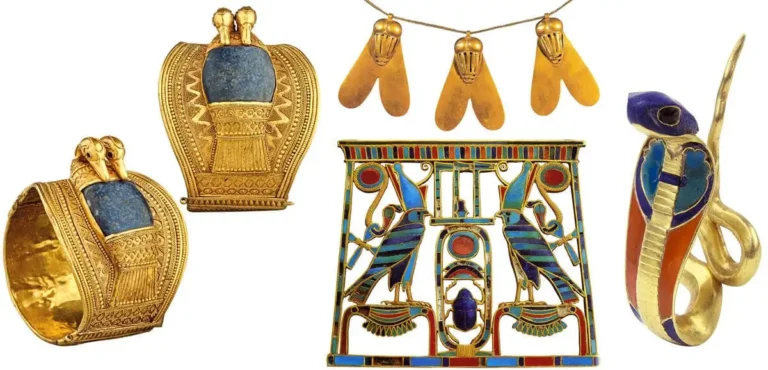
The tomb of a minor King, Tutankhamun, contained over 5,000 objects while being the smallest royal tomb of the Valley of the Kings. What would have been the treasure of the major Egyptian Pharaohs like Ramesses II?
And before that, the great pyramids? In total, ancient Egypt built over 120 pyramids, including the small pyramids made for Queens and Princes. Nearly all have been emptied of their mummies and their treasure, the only thing left were empty stone sarcophagi. Not a speck of gold, lapis or ivory to be found in pyramid burial chambers. At best fragments of royal bodies. The left foot of Djoser, the skull of Seneferu, the left arm of Unas…
Rare Examples of Egyptian Pharaoh’s Gold Jewelry
Fortunately several Royal jewelry masterpieces survive to give us an idea as to what the lost treasures might have looked like. They were found either by thieves or archaeologists. And sometimes by accident, like when railway workers stumbled upon a jewelry treasure. The archaeologist suspected it already was a looter’s cache buried two millennia previously. Among the treasure was a pair of gold and lapis lazuli bangles bearing the name of Ramesses II. We do not know if he did wear them, but it offers a glimpse to the lost contents of his tomb.
In 1920 an archaeologist discovered in a pyramid one gold and lapis lazuli cobra. It had been dropped by thieves while they cleared the burial chamber. To imagine what the rest might have looked like, one needs to look at Tutankhamun’s gold mask.
And however impressive its gold treasure, Tut’s tomb wasn’t intact, it had been visited by thieves, twice. Not a single intact Royal tomb had been found in ancient Egypt, until Pierre Montet’s discovery at Tanis.
Pierre Montet Discovered Intact Egyptian Tombs at Tanis
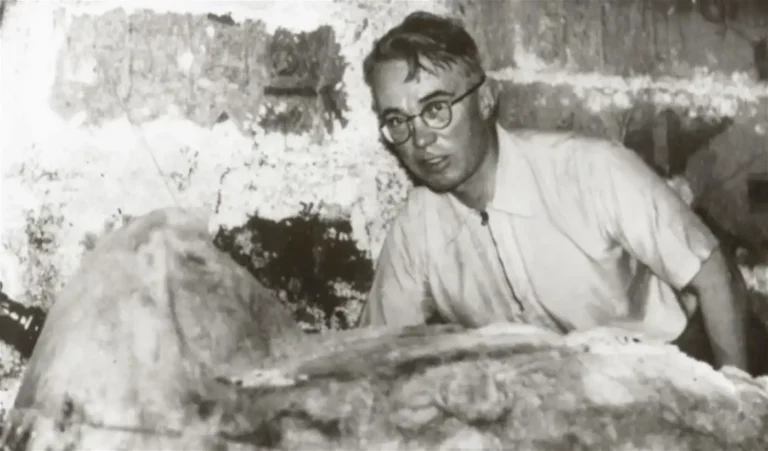
A glorious chapter of ancient Egyptian history was closed with Ramesses XI’s death. He wore a celebrated name but had none of the power or achievements. Egypt entered one of its chaotic episodes, and separated in two. Profaned, the Valley of the Kings was largely emptied of its treasures. Egyptian Pharaohs ruled from the Delta, in the North. This is how the city of Tanis became the new capital.
But that era was put into the ‘decline’ folder of Egyptian history. The city was built by simply using the city nearby built by the great Ramesses as a convenient quarry. High humidity left behind mostly stone fragments so it was unlikely that anything matching Tutankhamun’s discovery could ever be hidden there.
Minor Kings or not, Tanis used to be the capital of Ancient Egypt. And after ten years of effort, in the spring of 1939, Pierre Montet found stone slabs. Then a small gold item, whose quality indicated there was something special nearby. This was not the floor of a temple, but the roof of an underground necropolis.
Thieves had been there in Antiquity. Montet entered the hole they dug to find an empty tomb. But it was the tomb of a Pharaoh, Osorkon II. Then another sarcophagus was found, again emptied by robbers.
And then, a stone chamber without any signs of entry. Sliding inside the small chamber Montet saw “a falcon headed silver coffin. It appeared intact. Through a slot one could see gold shining inside”. Next to the silver falcon, “two skeletons under a multitude of torn gold sheets”. The history of Egyptian archaeology was about to be rewritten.
The Treasures of Tanis: Psusennes I, Amenemope and Shoshenq II
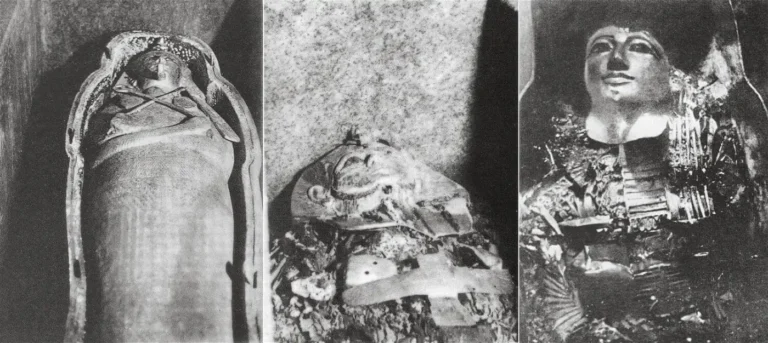
Montet had just found a Royal necropolis, home to a dozen Egyptian tombs of Kings and princes. The falcon shaped coffin held the mummy of Pharaoh Shoshenq II, until then a name completely unknown. So the discovery of the first Royal tomb ever found illustrated how much there still is to discover in ancient Egypt.
While the mummies had badly decayed, along with any text on papyrus, gold earned its reputation as eternal substance. Anything made of wood had vanished, but everything made of gold was intact.
Psusennes was buried inside a silver coffin. He was covered with a gold mask, six gold or lapis-lazuli necklaces, twenty-six bracelets and two pectorals. The larger necklace weighed 8 kg, made of thousands of individual gold pieces. One can compare it to the 10 kg (22 lbs) used for Tutankhamun’s mask.
Each lapis-lazuli necklace weighted 10 kg, the main gold necklace 8 kg (18 lbs), one gold bracelet nearly 2 kg (4 lbs). One wonders if Psusennes could even move if he wore all his jewels.
There also was a fourth lucky guest in the necropolis, a general named Undjebauendjed, whose tomb remained intact. He too was in a silver coffin and its mummy was covered by a solid gold mask.
With Pharaohs Shoshenq II and Amenemope, the treasure of Tanis amounts to nearly 600 objects. Three coffins of solid silver, four gold masks, gold and silver vases, and an astonishing collection of jewelry. Shoshenq’s pair of gold and lapis-lazuli bangles, as well as many of the other pieces illustrate that the jewelers of an era supposedly in decline could create wonders as amazing as those who did Tutankhamun’s.
Return of the Thieves
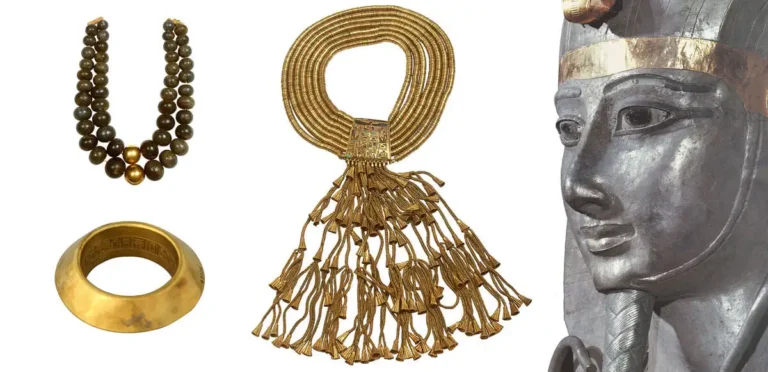
Montet contacted the Egyptian authorities as soon as the discovery was made, asking for all-around security. He reflected “I know by experience how much the discovery of gold unleashes a sort of gold folly. Like bees warned by a mysterious sense, people come from everywhere”. They did not need to travel very far, as some of the mission’s own workers were caught in the act. This is why the treasure was quickly sent to Cairo’s museum under army protection.
Then during the war, knowing the archaeologists would not return anytime soon, and that security was reduced, thieves returned. In 1943 robbers not only visited the home and storage of the archaeologists. They entered the tomb of Psusennes and attacked two walls in search of a jewelry cache. No jewels to be found, but they stole many statuettes.
The gold jewelry was in Cairo’s museum safe. But “in the basement of the museum other bandits managed to open the safe where the curators secured Psusennes’ jewelry, worried about bombings. An energetic investigation found the majority of what was stolen. Several elements of the necklaces and a few small objects are missing.”
Pierre Montet’s Discovery is as Significant as Howard Carter’s
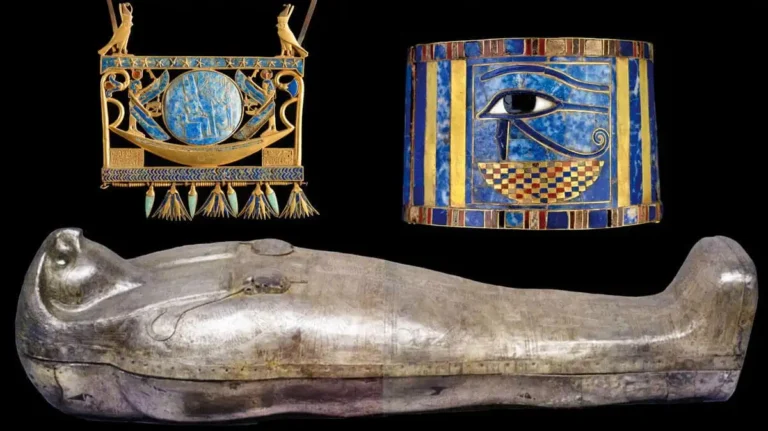
Montet described the importance of the treasure of Tanis as “the funerary monument of Psusennes, along with the two unforced Egyptian tombs can be thought as one of the most beautiful collections that Antiquity bequeathed us. It would have had the first place in ancient Egypt if the tomb of Tutankhamun did not exist”.
And the timing of its discovery, in 1939 and early 1940, did not help. Carter had the luxury of time to study the tomb, and let photographs of the treasure stir the world’s imagination. But Montet had to work fast. There was a war about to start and bandits waiting for him to turn his back.
This explains why there are so few photos of the discovery. Yet it is hard to understand why the treasure of Tanis remains unfairly overlooked, as it is even exhibited next door to Tutankhamun’s treasure.
Pierre Montet’s name should be regarded as highly as Howard Carter’s. He discovered the only intact Egyptian tombs of Pharaohs of three millennia of civilization. Uncovering an intact Royal necropolis was one of the most important finds of Egyptian archaeology.
The Gold of Tanis, a Find That Brought More Questions Than Answers
But there are puzzling aspects to the Tanis treasure. On the one hand, it is supposed to be ancient Egypt in decline. Something confirmed by how small and rather pitiful were the Egyptian tombs, built with fragments taken from temples, colossal statues and obelisks. The stone sarcophagi were re-employed from previous Pharaohs. Objects were found bearing the names of previous Pharaohs, like Ahmose and Ramesses II.
Yet the Tanis Kings were heavily decked in gold and silver. And the reign of Shoshenq was so short we have difficulty knowing how long it lasted. So the question remains, can we even grasp the quantities of gold held by the Pharaohs?
Trying to Quantify the Gold of Ancient Egypt
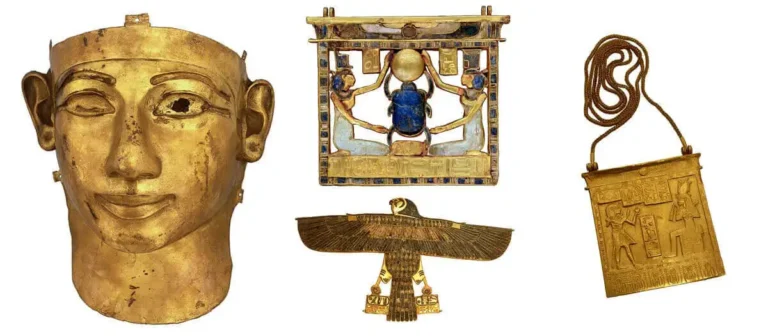
Gold wasn’t just covering royal bodies in life and inside the tomb. In some temples it covered walls, columns, doors, statues and furniture… Electrum, an alloy of roughly 80% gold and 20% silver, was used on the tips of both pyramids and obelisks.
What evidence do we have of the legendary gold of ancient Egypt? The Pharaohs’ own words:
– Amenemhat I “made a palace decked with gold, whose ceilings were of lapis-lazuli”.
– In Ramesses III’s palace “the “Great Seat” is of gold, its pavement of silver, its doors of gold and black granite”. And the same King had statues of gods made in “gold, silver, and every costly stone”.
– We also have the quantities of gold Pharaohs gave to Amun. The most generous was Thutmose III who gave 13,8 tons of gold and 18 tons of silver.
– However impressive they might be, these numbers pale in comparison to Osorkon I, one of the Kings at Tanis. He is recorded as having given to various temples 416 tons of precious metal. That is 25 tons of solid gold, 209 tons of electrum, and 182 tons of silver. The list is incomplete and includes a sphinx made of 4 tons of electrum.
Looting the Gold of Ancient Egypt
During the Assyrian looting of Thebes Ashurbanipal bragged having stolen “silver, gold, precious stones … two tall obelisks, made of shining electrum, whose weight was 2,500 talents”. The two electrum obelisks weighted 75 tons.
Another foreign loot of “silver and gold and costly works of ivory and rare stone” was done by the Persians. The Greek historian Diodorus records that “so great was the wealth of Egypt at that period, they declare, that from the remnants left in the course of the sack and after the burning the treasure was found to be worth more than three hundred talents of gold and no less than two thousand three hundred talents of silver”.
In other words, Diodorus was told that after the loot, there still was 9 tons of gold and 70 tons of silver left. This is how, visiting Egypt near the time of Cleopatra, he could still report that “no city under the sun has ever been so adorned by votive offerings, made of silver and gold and ivory, in such number and of such size”.
One problem about ancient sources is when they contradict each other. The pair of solid electrum obelisks would have weighted, according to Ashurbanipal who stole them, 75 tons. But from the records of the architect who likely made them, at most 3,3 tons in total.
Gold, Eternally Looted, Melted and Endlessly Reborn

The other difficulty is how to translate ancient weights into modern measurements. The Egyptian weight is the deben, corresponding to 91 grams (3.2 oz). But according to some sources, it needs to be understood as half of that for gold, or even 12 grams. It means all the numbers given previously might actually be lower. Like the gold and silver of Osorkon going from 416 tons to a mere 208 tons, or even in its lower equivalence, ‘only’ 55 tons.
In any case, are such quantities even possible? A more recent example is the gold taken from the New World between 1500 and 1660. The amount recorded on arrival in Spanish ports is 180 tons of gold and 16,600 tons of silver.
The other way to estimate the gold of Egypt is trying to establish how much has been mined. A thorough study evaluates the total amount mined during three millennia of Pharaonic Egypt to 7 tons. And it meant crushing up to 600,000 tons of rock to get that amount.
The Gold of the Egyptian Pharaohs
How can one reconcile all these dazzling numbers? Between what Pharaohs and foreign Kings claimed, what foreigners saw, or were told; and what is left, that is the treasures of Tutankhamun and Tanis? In Egypt, like everywhere else, gold, precious and easily melted, had been constantly mined, fashioned, melted, and fashioned again. At one time gold adorned gods, Pharaohs and nobles. Then it was stolen, melted, and back again to adorning nobles, Kings and so on.
Some of the gold of the Pharaohs might be in Assyria (Iraq), in Persia (Iran), in Greece, or in Rome (Italy). Some of it is also likely on sale today in the jewelry market of Khan el Khalili, Cairo.
The ancient Egyptians saw gold as the flesh of their gods, as a precious metal that would help them live eternally. As we have learned since then, gold does not even come from the earth, it was born among the stars billions of years ago. Maybe they were not wrong, after all, in thinking that gold was the substance of immortality.